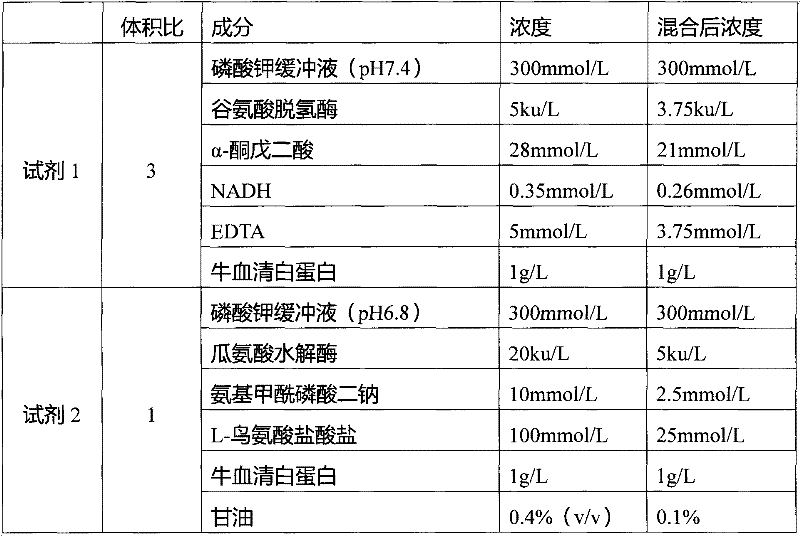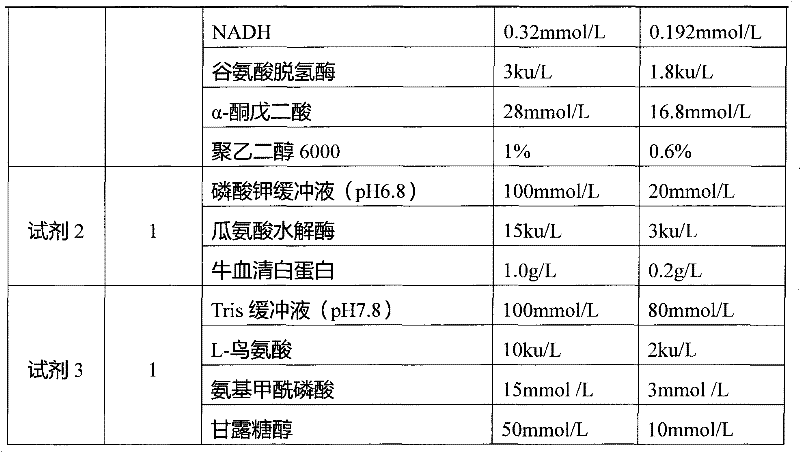Detection method for activity of ornithine carbamoyltransferase, and detection reagent thereof
An ornithine carbamoyltransferase and a determination method are applied in the field of medical inspection and determination, and can solve the problems of automatic analysis that cannot be large-flow, high price, complicated operation, etc., and achieve large-flow sample detection, low cost, and high sensitivity. high effect
- Summary
- Abstract
- Description
- Claims
- Application Information
AI Technical Summary
Problems solved by technology
Method used
Image
Examples
Embodiment 1
[0038] Embodiment 1 assay reagent
[0039] The assay reagent is in the form of lyophilized powder, and the ingredients are listed in the table below:
[0040] Element
[0041] When used, dissolve the assay reagent with pH 7, 150 mmol / L sodium phosphate buffer. Cooperate with commercially available reagents for the determination of ammonia, and measure the activity of ornithine carbamoyltransferase on the samples to be tested.
Embodiment 2
[0042] The determination of embodiment 2 ornithine carbamoyltransferase activity
[0043] Instrument: UV constant temperature spectrophotometer
[0044] Determination reagent: a single reagent in the form of aqueous solution, the ingredients are shown in the following table:
[0045] Element
[0046] During the measurement, there is no fixed requirement for the ratio of the reagent to the sample, but it should be consistent within the same measurement batch. Here, the reagent:sample ratio is 3000:100. Add the sample to be tested to the reagent pre-warmed at 37°C, and measure after a delay of 2 minutes. Measure the absorbance change value of the reaction system within 10 minutes, and the measurement wavelength is 340nm.
Embodiment 3
[0047] The determination of embodiment 3 ornithine carbamoyltransferase activity
[0048] Instrument: automatic biochemical analyzer
[0049] Determination Reagent: A two-component kit in the form of aqueous solution, the ingredients are shown in the table below:
[0050]
[0051] During the measurement, there is no fixed requirement for the ratio of reagent to sample, but it should be consistent within the same measurement batch. Here, reagent 1: sample: reagent 2 is 1800:80:600. Add the sample to be tested to reagent 1, incubate at 37°C for 5 minutes, and read the blank value of the sample, then add reagent 2, and measure after a delay of 2 minutes. Measure the absorbance change value of the reaction system within 15 minutes, and the measurement wavelength is 340nm. It is also possible to mix Reagent 1 and Reagent 2 before measurement, and then measure as a single reagent.
PUM
 Login to View More
Login to View More Abstract
Description
Claims
Application Information
 Login to View More
Login to View More - R&D
- Intellectual Property
- Life Sciences
- Materials
- Tech Scout
- Unparalleled Data Quality
- Higher Quality Content
- 60% Fewer Hallucinations
Browse by: Latest US Patents, China's latest patents, Technical Efficacy Thesaurus, Application Domain, Technology Topic, Popular Technical Reports.
© 2025 PatSnap. All rights reserved.Legal|Privacy policy|Modern Slavery Act Transparency Statement|Sitemap|About US| Contact US: help@patsnap.com



